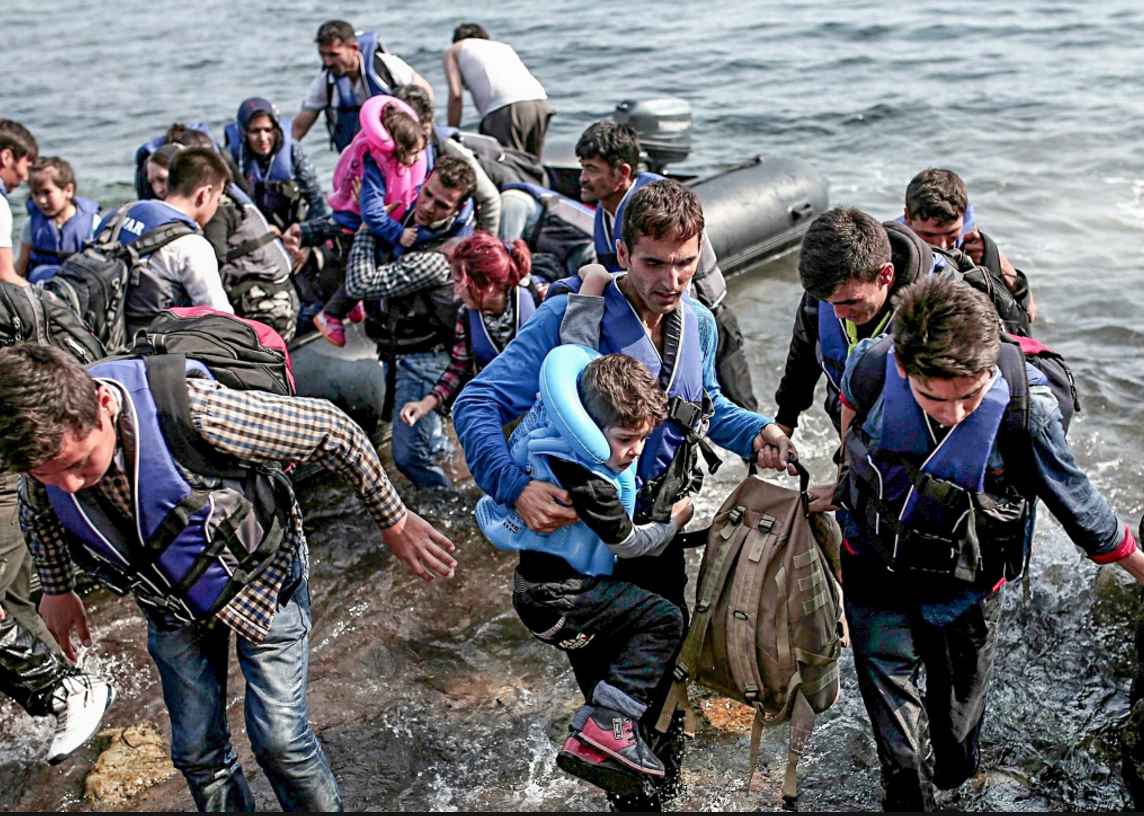This week’s Water Cooler question:
Unless you’ve been living under a rock in Thunder Bay, you’ve heard about Russia’s President, Vladimir Putin, and his internationally condemned dabble in the Ukraine. You’ve heard about the emerging power of China in regards to its economic, political and military might, and you’ve heard about the particular devastation in Syria and Iraq attributed to the self-proclaimed Islamic State.
To some, it appears the old order of the world with the United States as the hegemonic power, preaching capitalism and democracy as the deemed “ideal” for every other state to follow, is slowly transforming into something different. Whether this difference is good or bad depends on who you talk to.
In regards to these three actors on the global stage, from a Canadian and American perspective specifically, what is the greatest threat to global stability?
For this Water Cooler, the NAoC is pleased to bring you an opinion provided by Colonel Lawrence Wilkerson, a Distinguished Visiting Professor of Government and Public Policy at the College of William and Mary in the United States. You can read more about him here.
What is the greatest threat to global stability: Russia, China or the Islamic State?
The Responses
Trevor: The Jihadi Next Door
Program Editor, Canada’s NATO
The fact that a coalition of some 60 countries is either directly or indirectly helping in the fight against IS shows that it is truly the global threat of our time.
Not only has IS been able to capture large swaths of territory in Iraq and Syria, it has now made its way into countries like Egypt, Libya, Yemen and Afghanistan. Several groups such as Boko Haram in Nigeria and Al Shabaab in Somalia have also pledged allegiance to IS securing its influence throughout Africa. The rise of IS has led to the instability of both countries and people, killing thousands of civilians and displacing millions more.
IS’ reach is not limited to the Middle East and Africa however, thousands of citizens from Western countries like the UK, France, US, Canada, and Australia have left their respective countries to go and fight with IS in Syria and Iraq. Many who come back with the knowledge and training to potentially carry out attacks in their home countries.
IS has also shown its truly global reach with the acts of so called lone wolf terrorists who have no physical connection with IS yet carry out attacks in their home countries, as seen recently in Canada, US, France, UK, Tunisia, and Australia.
Corinne: The Russian Bear
Program Editor, Society, Culture and International Relations
Russia has been historically symbolized as a bear, whether tsarist, communist or a federation. As a state actor in the international arena it has always been aggressive. The annexation of the Crimea in the Ukraine is only the most recent consequence of this aggression. You can go as far back as the Crimean War in 1853 to the Cold War to see clear examples of this characteristically Russian behavior. This antagonism ends in a lack of respect for the sovereignty of states and a strong willingness to use force. This threatening and alarming behavior is inherent to Russia’s conduct in the international arena, and this is what makes Russia the greatest threat to global stability. The symbol of the bear implies that Russia is big, brutal, and cunning, and Russia has proven time and again that that is exactly how it will always behave.
Jeff: ISIS, and the Ideas Behind It
Program Editor, International Business and Economy
ISIS differs from the other two in the sense that it is not built on the concept of nationalism or even modernity. It’s built on a concept (read: perversion) of medieval Islam based on prophetic law. They literally want the world to end. That uniform, all-encompassing fervor towards their ideology simply does not exist within Russia and China, making ISIS completely less predictable and that much more dangerous. Call Putin a mad dog, but Russia and China still operate within the realms of logic and self preservation. They aren’t about to go head-to-head with NATO, no matter what scaremongers would like to claim.
The problem with ISIS is that it isn’t just ISIS. It’s entire generations of people that lack identity and self-fulfillment and turn to this radical, twisted form of Islam as a solution. Destroying Raqqa or assassinating al-Baghdadi isn’t going to change anyone’s mind when they already have nothing to lose. The chief killers of humanity are not sharks, like Putin, or tigers, like Xi. It’s the plague of radicalism that threatens the fabric of global stability today, and there is no easy cure.
Hasan: The Dormant Threat
Program Editor, Expanding Community
A threat is something that affords to radically shift any norm, for the threat itself sees the norm as an obstacle which needs to be overcome. A threat is not necessarily widespread and can be dormant. A short term concern can evolve into a serious threat and a long term concern may be overstated.
ISIS, although loud, violent, and widespread across various continents, whether it be in actual presence or sympathy, has no long term viability. Just like it fizzled out as ISI when Iraqi Sunnis actively rose against them, it needs a certain environment to spread, it does not generate that environment but is the by-product.
State actors can create environments, willingly or unwillingly, which affect global norms. Had the U.S. not invaded Iraq in 2003, would ISIS have grown to what it is now? No. The threat looms, in my opinion, from China, and to an extent, Russia. Dormant and influential, the stage is set over decades to change the balance of power, fueled by economic growth and expenditure – not beheadings and effective marketing.
Russia’s capacity to global hegemony is no more but China has the economic and political influence to establish a new global standard.
Stefan: ISIS is a Symptom of a Larger, More Dangerous Problem.
Program Editor, Procurement
ISIS in and of itself is not the greatest threat to global stability. But the broader problem it represents certainly is. The Sykes-Picot boundaries of the Middle East are gradually, but steadily breaking down. The divide between Sunnis, Shias and Kurds has become more pronounced than ever before. The rise of the Islamic State in Iraq and Syria speaks to the complete failure of political and religious pluralism in the region. The continuing Saudi-Iranian struggle for regional dominance, plus the tense situations in Yemen and Lebanon, speaks to the fact that many Middle Eastern governments do not truly represent their populations as whole. There is persuasive evidence that ISIS will eventually be contained through military means. But a military victory will not solve the underlying political and sectarian dilemmas that underlie the rise of ISIS and similar groups. Just as ISIS eventually eclipsed al-Qaeda, another similar situation could occur in the future. Left unaddressed, the stubborn problems at the heart of the modern Middle East will pose an immense risk in the decades to come.
Lawrence Wilkerson: Crouching Tiger?
Distinguished Visiting Professor of Government and Public Policy, College of William and Mary
Of the immediate threats confronting the United States today, China stands first. There are several reasons for this. First, U.S. leaders’ misunderstanding of China continues apace. Second, China’s rulers’ void of ideological appeal—what Communism provided for Mao—has been filled by aggressive nationalism. Third, China’s military has matured, gained considerable influence, and wants to prove itself. Fourth, China’s economic position is increasingly precarious. Last, China has painted itself into a corner over its exorbitant claims in the South China Sea (SCS). Beijing’s breasting the beast—the United States—is easily done there, feeding the nationalism that has become China’s ideology, salving the military’s thirst for action, and diverting China’s vast population’s attention from a flagging economy. Operating on more or less interior lines in the SCS also provides China with a similar advantage to Putin’s with respect to Ukraine, i.e., China is very close-by while the U.S. is several thousands of miles away. Add to this already volatile mix what James Bradley points out in his book The China Mirage, that the U.S. has in the past generated disasters in the Pacific because of its misreading of China, and we have the greatest immediate threat to U.S. national security.
Michael: Overreaction to Inflated Threats Poses The Greatest Danger.
Program Editor, Emerging Security
As scholar Stephen Walt observes, the Islamic State’s “total fighting force is smaller than two U.S. Army divisions and its territory is mostly worthless desert.” The threat it poses is asymmetrical: inspiring homegrown terrorist attacks by sympathizers living in the West or provoking the U.S. and its allies into launching another protracted military intervention in the region.
Russia’s actions in Ukraine were taken in response to perceived Western encroachment on its sphere of influence. With Russia’s best forces tied down in Ukraine, combined with long-term problems of demographic decline and a static economy overly dependent on energy exports, it will confine itself to spoiling various Western diplomatic initiatives and driving a wedge inside NATO by instilling doubt among its Eastern European members of America’s readiness to come to their defence. The trappings of a mischievous actor, yet hardly the “existential threat” that senior Pentagon officials proclaimed.
The China threat has been exaggerated. It confronts many structural problems – an underdeveloped countryside, income inequality, a flimsy social safety net as the population rapidly ages- that will constrain its development, in addition to being hemmed in on all sides by regional actors wary of its influence. China’s ascent, however, poses the clearest long-term threat to global stability. The likelihood is that America will resist accommodating China’s expanding ambitions, leading to heightened strategic competition.







